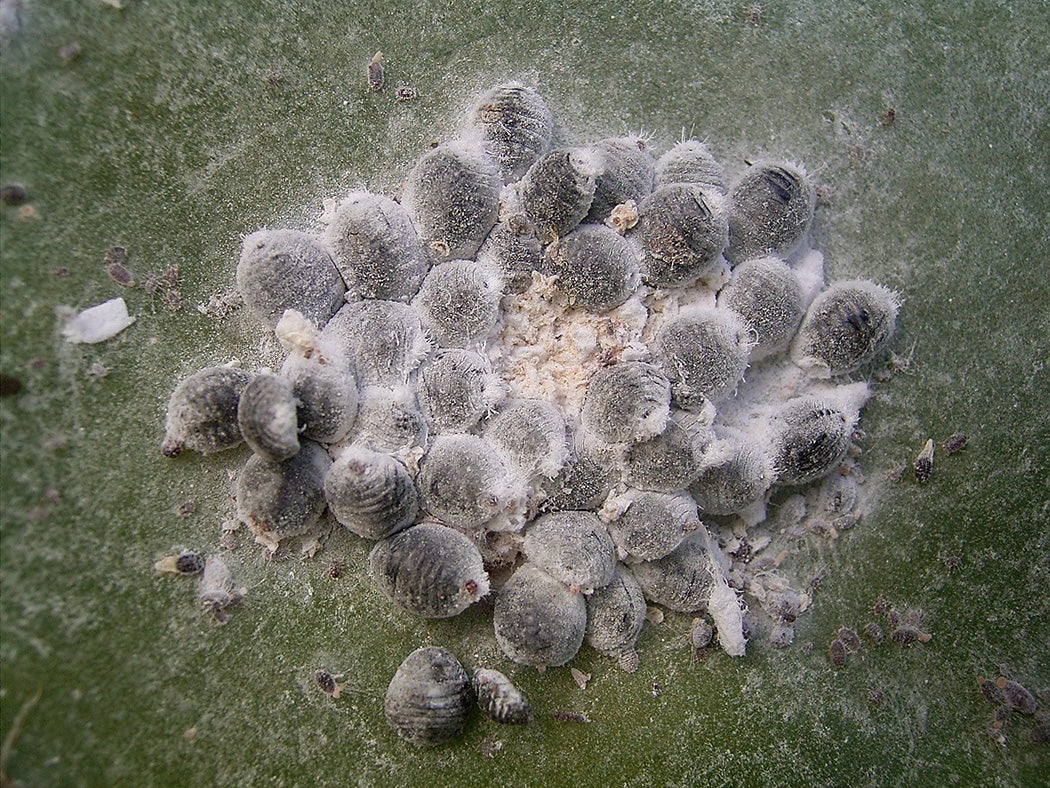Ever wonder where natural red dye comes from? Many of our favorite colors have complicated backstories, but red might take the cake when it comes to the gross-out factor. As art historian Elena Phipps writes, “Red—associated with blood, fire, fertility, and life force in many cultures throughout the world—has always been one of the most highly prized colors, in part because it is among the most difficult to achieve.” Indeed, the brilliant hues of crimson lipstick, Campari, “natural” food coloring, and the red used to make some of the world’s great textiles and paintings were (and in some cases, still are) derived from crushed cochineal insects.
As Phipps explains, red dyes—called kermes, lac, and grana—have been sourced from scale insects in the superfamily Coccoidea for a long time. But none of the Old World insect sources “could match the deep crimson color, ease of use, and abundant supply of dye extracted from Dactylopius coccus.” This uniquely vibrant red comes from an American insect species that feeds on cactus. The insects were domesticated and used “profusely” by Pre-Columbian peoples beginning at least 2,200 years ago. Phipps notes:
To make cochineal red, the colorant (mainly carminic acid) is extracted from the dried bodies of the female insects in water. A mordant, or mineral salt, often alum (aluminum sulfate), is required to help bond the dye to the fibers. Other additives such as acids and alkali have traditionally been used to shift the naturally bright pink hue of cochineal to deep crimson, purple, or black.
The Spanish started shipping cochineal from the New World as soon as they found out about it. And even before that, Europe was primed for a really good red. In 1464, nearly thirty years before Columbus, the over-harvesting of the shellfish used to make the purple associated with both royalty and the Catholic Church caused the Pope to decree that red could now be used for costuming prelates. Yes, “cardinal red” was actually preceded by “cardinal purple.” By the mid-sixteenth century, tons of the dried insects were being shipped to Europe for use in dyes.

Phipps writes: “Cochineal, along with gold and silver from the Americas, enabled the Spanish Crown to finance its empire […] while establishing its global monopoly and dominance of sea trade.” But Spain couldn’t hold its monopoly on the color-source forever. All Europe wanted it, and other powers were soon making inroads into the market for it. The color trade became international. Great Britain’s Redcoats were literally named after the cochineal dyed wool uniforms they wore.
The pigment was also used in painting. Lake pigment, prepared with cochineal extract, was prized for its vibrancy and used by the likes of Rembrandt and Van Gogh. By the middle of the nineteenth century, painters were using synthetic dyes. Similarly, aniline dyes, which are made from coal-tar derivatives, pretty much wiped out the cochineal market in the realm of textiles.
So how did carmine, as it’s often called in the food world, end up in today’s food and drink? Eye-appeal: the stuff is tasteless, so the resulting pinks and reds were merely visual stimulants. Food, cosmetic, and drug manufacturers have continued using insect-based tints. Concerns about the carcinogenic effects of the artificial reds—which are still made from coal and petroleum—have helped keep the cochineal trade going.
Weekly Newsletter
Vegans and animal rights groups have challenged the use of these insects. In 2012, Starbucks, for one, agreed to phase out the use of cochineal extract. Yet the color remains pervasive in food products. Two millennia on, we keep on fattening up these little bugs with cactus, so that we can enjoy colorful treats like red velvet cupcakes.







